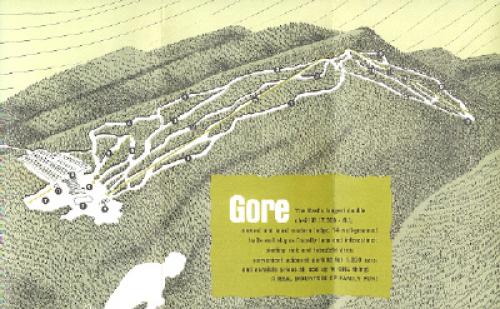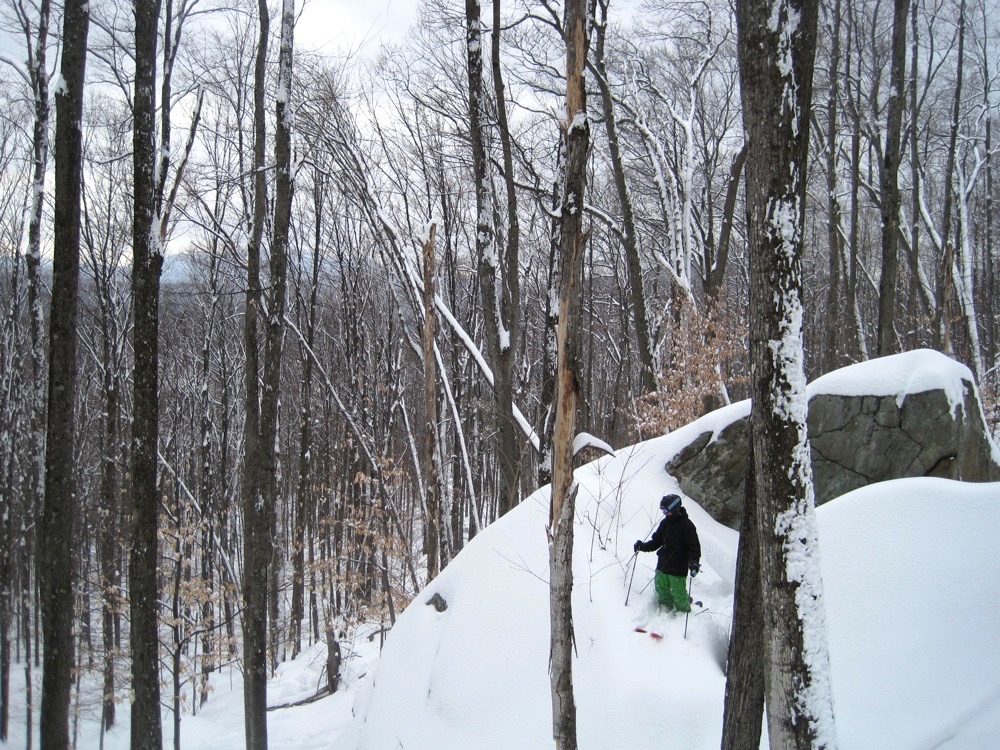I hear a lot about the flat spots at Gore — like it or not, they’re part of the Gore Brand. In the beginning during the ride up and slide down days, heels were free and trails like Rabbit Pond followed rolling terrain going both up and down. Nobody seemed to mind the exercise.

During the early period of lift served skiing on Bear Mountain, in the mid-sixties, there were no flat spots. The East and the North Sides functioned nicely as a mountain with higher elevations, more vertical and more terrain than the Ski Bowl.
In the late sixties, the funds became available to develop the true summit of Gore. Some of the very best terrain at Gore Mountain was added under the Straightbrook and Summit Chairs.
Hawkeye, Chatiemac, Headwaters, Lower Steilhang and Hullabaloo put true expert terrain onto the trail map. At that time there was only one way to get down to the base, without adding yet another lift. “Cloud” was born.

Cloud is probably Gore’s most infamous flat spot. But for years without funds for more expansion, it made skiing from the summit possible.
You can’t deny that Cloud is still useful. When the end of a ski day is approaching and you want to maximize runs at the top, you can squeeze in one more by consenting to “Cloud Out.” It’s still the fastest way from the summit to the base. One thing is certain, Gore mountain wouldn’t be as connected as it is, without those flat trails — Cloud, the Pipeline, Hedges, Cedars and Tannery.
If you don’t like skating the flats at Gore, you have to take it up with the State of New York. Either you don’t like the original decision to put a ski hill on Gore Mountain, or you disagree with the way expansions have been made. You can’t really argue that point. If you didn’t develop the summit, Burnt Ridge and the Ski Bowl, you wouldn’t have connector trails.

I like the expanded terrain, and it would be far less accessible without the connector trails. Much of the best terrain at Gore requires some effort. This is true at other mountains too. My favorite terrain at Whiteface, the Slides, requires a ten-minute sidestep to access. It can be tiring, but I’d do it all day long, if they’d let me.
I’ve heard a variety of creative solutions suggested to “fix” these problems. And if any of them are implemented, I’ll certainly take advantage of them. For now, I’m enjoying the all of the terrain added since 1965 — Gore Mountain is a big, fun and interesting place to ski. And if the interconnect is a little less crowded because of the effort required, I’m ok with that too.

Is the cirque really longer than sugar valley glades from the top entrance all the way to kids kampus? the cirque takes longer to ski because of all the flat spots you have to walk across so its not really all fall line skiing like SVGs are.
Whiteface has the greatest vertical in the east, but Gore has the most horizontal.
I have always felt the flat spots gave Gore character. It makes it more of a multi-mountain area, as opposed to a mountain where you ski the full vertical every time (think Mad River Glen, Bromley, or Magic. Up down, up down)
You have to decide which part of the mountain you want to ski on. Stay there for a while. Then after lunch, hit another "pod." It is like skiing multiple ski areas in one day.
Granted, I am not a snowboarder: I don’t think I would enjoy Lower Cloud on a board. Harv, you should mention the trail added as an alternative to Lower Cloud about 1976 – 1989ish: Lower Tannery. Great concept, a direct run from the bottom of Chatiemac straight to the base lodge. Only problem is that it was flatter than Cloud, so they ended up closing it. Imagine that, a trail flatter than the bottom of Cloud. But it was.
Yet another good summer story. Thanks.
There’s no questioning the fact that the tremendous amount of horizontal at Gore adds character and allows Gore skiers to become stronger skaters (or get tired early!), but it’s undeniable that there is a really good reason that no other alpine ski area has so much horizontal.
TBH, I’m not sure if Cirque glades have more vert than Sugar Valley Glades or not. I knew SVG was the other contender for longest glade in NY and tried my figure out the vert, but couldn’t do it. If anyone knows the vert of SVG and if it exceeds 1200 feet I will make the change to the caption above.
When I mentioned Tannery above, I was actually referring to the full length of the trail, both upper and lower. Lower Tannery is still used on occasion. The last time I skied it was 2008.
The different terrain pods are part of what make Gore great. Too crowded? Go to another area. Marginal conditions? Go to another area. Too much wind? Go to another area. Bored? Go to another area. Tracked out? Go to another area. Etc. Etc. Etc.
I consider the flat spots to be a side effect of having the freedom to change things up. It’s not that big a deal and a little extra exercise never hurts.
The great flat area after Windy Hill was certainly the most reviled flat but the bottom of Tannery if you ducked the rope and got “one more” on Chatiemac or Hawkeye. There were others, like the bottom of Sunway, Woodout, and that attempt at a terrain park (Gorey Gully?) bottom of Burnt Ridge. The latest is the trip over to Sagamore. I have no valid complaints these days except maybe that the old Summit chair is false advertising!
Very good point Yukon – I was at Gore President’s Weekend last winter and by parking at the ski bowl we hardly had any lines.
Who’s the skier about to drop cirque?
That is Condor. I believe he has since flown out west!
If anyone sees him, please ask him to stop by and say hello. 🙂